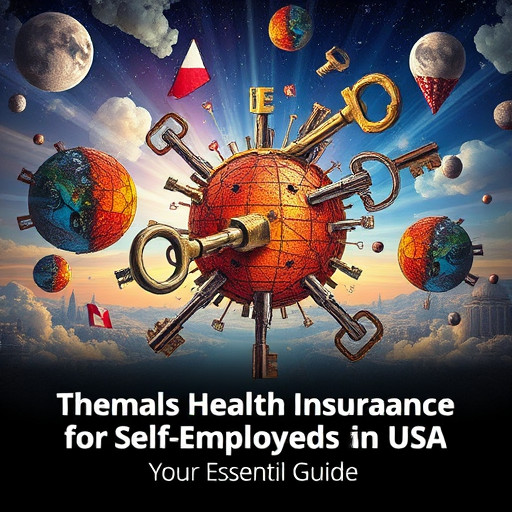Discovering the Perfect Fit – How to Choose the Right Life Insurance Policy for Your Needs

When it comes to financial security and planning for the future, understanding how to choose the right life insurance policy is crucial. Many people approach life insurance with uncertainty, unsure of what type or amount they should consider. However, by equipping yourself with knowledge and taking the time to evaluate your individual circumstances, you can ensure that you select a policy that meets your needs and those of your loved ones.
Understanding Life Insurance Basics
Before diving into how to choose the right life insurance policy, it’s essential to grasp the basic concepts of life insurance. This foundation will help inform your decisions as you explore various options.
What is Life Insurance?
Life insurance is a contract between an individual and an insurance company. In exchange for regular premium payments, the insurer promises to pay a designated beneficiary a sum of money upon the policyholder’s death.
This financial safety net serves various purposes, including covering funeral expenses, paying off debts, and providing ongoing income for dependents.
Types of Life Insurance
Several types of life insurance policies exist, each with its unique features. Here are two of the most common types:
- Term Life Insurance: This policy covers you for a specified term—typically ranging from 10 to 30 years. If the policyholder dies during this term, the beneficiaries receive the payout. If the term ends and the policyholder is still alive, coverage ceases unless converted to permanent insurance.
- Whole Life Insurance: Unlike term life, whole life insurance provides lifelong coverage, as long as premiums are paid. This policy also includes an investment component known as cash value, which grows over time and can be borrowed against.
Key Factors to Consider
Now that you have a basic understanding of life insurance, several factors are critical when determining how to choose the right life insurance policy.
- Your Financial Responsibilities: Assess your current debts, ongoing financial obligations, and future expenses.
- Dependents’ Needs: Consider your family’s financial needs should you pass away unexpectedly.
- Budget: Determine how much you can afford to pay in premiums monthly without straining your finances.
The knowledge you’ve gained about life insurance basics sets the stage for a more informed discussion about selecting the right policy.
Evaluating Your Personal Needs
Understanding your personal situation is vital to choosing the right life insurance policy. It’s not merely a one-size-fits-all decision; your unique circumstances will guide your choice.
Assessing Financial Responsibilities
The first step in evaluating your personal needs is to assess your financial responsibilities thoroughly.
- Debt Obligations: Consider any significant debts, such as mortgages, car loans, student loans, or credit card debt. Life insurance can cover these liabilities, ensuring your family does not inherit financial burdens if you were to pass away.
- Living Expenses: Estimate your household’s monthly living expenses, including groceries, utilities, and other recurring bills. This calculation gives insight into how much income your dependents would need to maintain their lifestyle.
- Future Expenses: Think about upcoming costs like college tuition for children or care services for elderly parents. Factor these potential expenses into your overall financial picture.
Identifying Dependents’ Needs
https://www.profitablecpmrate.com/dexuw7mhmv?key=6503b2f78ec4209747696c3d01ba1d23
Next, it’s essential to think about the needs of your dependents, as they play a crucial role in determining which policy best suits your situation.
- Spousal Needs: If you have a spouse or partner, consider how their financial stability would be affected by your absence. Ensure that your life insurance policy safeguards their quality of life.
- Children’s Needs: Children often rely on their parents for financial support until they reach adulthood. Calculate how much coverage would be needed to provide for them until they can become financially independent.
- Other Dependents: Additionally, consider whether you have other dependents, such as elderly parents or siblings who rely on you, and factor their needs into your decision.
Budgeting for Premiums
Finally, evaluate your budget to determine how much you can comfortably spend on life insurance premiums without compromising your other financial obligations.
- Monthly Income: Review your take-home pay and ascertain how much you can allocate for insurance.
- Lifestyle Priorities: Ensure that your chosen policy aligns with your lifestyle choices and future goals while providing adequate coverage for your dependents.
Taking time to evaluate your personal needs will significantly impact your ability to choose the right life insurance policy that effectively protects your loved ones’ futures.
Weighing the Pros and Cons
In any decision-making process, weighing the pros and cons is essential. When it comes to life insurance, there are clear advantages and disadvantages associated with various policies.
Benefits of Life Insurance
There are numerous benefits to obtaining a life insurance policy, which makes it a valuable part of financial planning.
- Financial Security: Life insurance provides peace of mind knowing that your loved ones will be financially secure even in your absence.
- Debt Coverage: As previously mentioned, life insurance can help pay off any existing debts, alleviating financial strain on your family.
- Tax Benefits: In many instances, life insurance benefits received by beneficiaries are tax-free, making it an efficient way to transfer wealth.
Drawbacks of Life Insurance
While there are numerous benefits, it’s also essential to consider the drawbacks associated with life insurance policies.
- Cost of Premiums: Depending on the type and amount of coverage, life insurance premiums can be costly, especially for whole life policies due to their investment components.
- Complexity of Products: Navigating the variety of products available may feel overwhelming, leading to confusion when trying to determine which policy best fits your needs.
- Opportunity Costs: Funds allocated towards life insurance premiums could potentially yield higher returns if invested elsewhere, particularly in retirement accounts or stock market investments.
Carefully weighing the pros and cons of life insurance will empower you to make an informed decision that aligns with your overall financial strategy.
Exploring Alternatives to Life Insurance
While life insurance is a commonly recommended financial tool, it may not always be the best fit for everyone. Exploring alternatives can help you decide how to protect your loved ones comprehensively.
Savings Accounts
A high-yield savings account can serve as a short-term alternative to life insurance for individuals who have fewer financial obligations or young dependents.
- Accessibility: You retain easy access to your funds, allowing you to withdraw if needed for emergencies.
- Growth Potential: Although interest rates may vary, your money has the potential to grow over time.
However, it’s important to remember that savings alone won’t offer the same level of security that a life insurance policy provides for dependents.
Investments
Investments such as stocks, bonds, or mutual funds can be viable long-term alternatives to life insurance, providing liquidity and growth potential.
- Wealth Creation: Depending on market conditions, investments have the potential to yield higher returns compared to life insurance cash values.
- Financial Independence: Building an investment portfolio can create a cushion for your family, helping them transition through tough times without relying solely on insurance proceeds.
Nevertheless, unlike life insurance, investments carry inherent risks, and their value may fluctuate depending on market performance.
Prepaid Funeral Plans
For individuals looking to relieve their families of funeral expenses without traditional life insurance, prepaid funeral plans can be a suitable alternative.
- Specific Purpose: These plans address the immediate need for funeral-related expenses, ensuring that loved ones do not face the burden of costs during a sensitive time.
- Flexibility: Most funeral homes offer flexible payment options, making it easier to manage costs.
However, prepaid funeral plans may limit flexibility concerning final arrangements, and it’s advisable to research different providers before committing.
Exploring alternatives empowers you to develop a comprehensive financial strategy tailored to your unique needs.
Step-by-Step Guide to Choosing the Right Life Insurance Policy
Navigating the complexities of life insurance requires a systematic approach. Here’s a detailed step-by-step guide to choosing the right life insurance policy for your specific circumstances.
Step One: Assess Your Coverage Needs
Begin by calculating how much life insurance coverage you need.
- Income Replacement: A common rule of thumb suggests having at least 10-15 times your annual salary in coverage.
- Debt and Expenses: Include any debts, living expenses, and future obligations in your calculations.
Documenting these figures will provide clarity as you progress through the selection process.
Step Two: Determine the Type of Policy
Next, identify which type of life insurance policy best suits your needs: term or whole life.
- Term Life Insurance: Ideal for those seeking affordability and temporary coverage. Consider this option if you only need protection for a limited time.
- Whole Life Insurance: If you want lifelong protection and are open to paying higher premiums for cash value accumulation, this could be your best choice.
Be sure to weigh the benefits and drawbacks of each type to make an informed decision.
Step Three: Research Providers
Once you’ve identified your coverage needs and preferred policy type, research various insurance providers.
- Reputation: Look for companies with strong financial ratings and positive reviews from current and former customers.
- Customer Service: Assess responsiveness to inquiries and claims processes to ensure a smooth experience.
Taking time to compare quotes and customer experiences will help you find a reputable provider that aligns with your values.
Step Four: Consult with a Professional
Engaging with a licensed insurance agent or financial advisor can provide invaluable insights into your specific needs.
- Personalized Recommendations: A professional can analyze your financial situation and recommend tailored policies based on your needs.
- Policy Explanations: They can clarify any confusing terms and conditions within policies, ensuring you fully understand your options.
Consulting with an expert can provide additional confidence when making your final decision.
Step Five: Review and Finalize
After consulting with a professional, review your top choices before finalizing your decision.
- Compare Policies: Evaluate coverage amounts, premiums, and additional features such as riders that could enhance your policy.
- Read the Fine Print: Before signing, read all terms and conditions carefully to avoid surprises down the road.
Finalizing your choice with thorough consideration ensures that you select the right policy for your unique circumstances.
Tips for Choosing the Right Life Insurance Policy
Equipped with knowledge, here are some practical tips to help you navigate the process of choosing the right life insurance policy successfully.
Start Early
One of the best pieces of advice is to start thinking about life insurance early.
- Health Factors: Obtaining insurance when you’re younger and healthier typically results in lower premiums.
- Long-Term Planning: By starting early, you lock in coverage for the future, making it a proactive step towards financial security.
Be Honest About Your Health
When applying for life insurance, honesty is paramount, especially regarding your health history.
- Accurate Underwriting: Providing truthful information allows for accurate underwriting, ensuring appropriate coverage at fair pricing.
- Avoid Future Issues: Misleading answers could lead to denied claims in the future, undermining the purpose of having life insurance.
Being honest from the outset fosters trust and integrity in your relationship with your insurer.
Keep Your Beneficiaries Updated
As your life evolves, so do your relationships and financial obligations. Regularly reviewing your beneficiaries ensures that your life insurance policy reflects your current wishes.
- Significant Life Changes: Major events such as marriage, divorce, or the birth of a child should prompt a reevaluation of your beneficiaries.
- Documentation: Keeping beneficiary designations up to date prevents confusion and ensures that your intentions are respected.
Regularly updating your beneficiaries enables your loved ones to benefit from your policy according to your current desires.
Frequently Asked Questions
What factors influence life insurance costs?
Various factors affect life insurance costs, including age, gender, health status, lifestyle habits (e.g., smoking), and the type and amount of coverage desired.
Can I change my life insurance policy after purchase?
Yes, you can usually adjust your policy after purchase, including increasing or decreasing coverage amounts and changing beneficiaries. However, consult your provider for specific terms.
How often should I review my life insurance policy?
It’s wise to review your policy annually and whenever significant life changes occur, such as marriage, a new child, or a change in financial situation.
Do I need a medical exam to obtain life insurance?
Not all life insurance policies require a medical exam. Some insurers offer no-exam policies, though premiums may be higher due to the increased risk.
Is life insurance worth it?
Life insurance is generally considered a valuable financial tool for providing security and peace of mind for dependents. The worthiness of a policy depends on individual circumstances and goals.
Conclusion
Understanding how to choose the right life insurance policy is essential for safeguarding your loved ones’ financial futures. By assessing your needs, weighing the pros and cons, exploring alternatives, following a systematic step-by-step guide, and incorporating practical tips, you can make an informed decision that aligns with your unique situation. Remember, life insurance is not just a product; it’s a commitment to providing security and peace of mind for those you care about most. Take the time to educate yourself, consult experts, and ensure that you make the best choice for your family’s future.



Leave a Comment